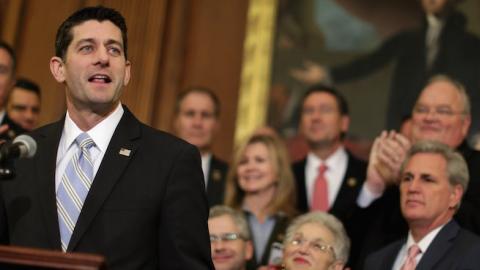When the new Congress and President-elect Trump take office in January, Republicans will have a real chance to repeal President Obama’s Affordable Care Act. If they succeed, it will be the result of their carefully executed strategy to repeal the law and repeated congressional votes to do so. This approach was the subject of much derision from Democrats, but sticking to it has now put the Republicans in a position where they can reach their goal.
When Republicans won the House of Representatives in 2010, they immediately began repeal efforts. Since January 2011 the House has passed more than 50 bills that would repeal all or some of the Affordable Care Act. House Republicans knew that repeal had no chance of passing a Democratic Senate, but the votes placed a marker showing that a duly elected arm of the U.S. government opposed the law and was willing to take steps to repeal it.
Democrats and liberal pundits were merciless in their critique of Republican efforts. As comedian Bill Maher put it, “The Republicans in Congress voted to repeal ObamaCare for a 40th time today. It’s really now less a governing philosophy, and it’s more like Charlie Manson applying for parole.”
After Republicans won the Senate in 2014, the upper chamber worked with the House to repeal core provisions of ObamaCare via the budget process. This legislation reached President Obama, who vetoed it. The reaction was again dismissive: “It got them nothing, and with the stroke of a pen, the president dispensed with it,” said White House Press Secretary Josh Earnest. Yet Republicans had demonstrated a legislative path to repeal.
The accusation that Republicans have no plans for an appropriate replacement is false. The GOP has multiple plans, including House Speaker Paul Ryan’s “A Better Way” as well as plans from Sens. Richard Burr and Orrin Hatch and Rep. Fred Upton; Rep. Pete Sessions and Sen. Bill Cassidy; Rep. Tom Price, Sens. John McCain and David Perdue; Rep. Phil Roe and the Republican Study Committee; and Sen. Ben Sasse, among others. Add to this “Improving Health and Health Care: An Agenda for Reform,” the consensus health-reform plan by conservative scholars, including one of us (Mr. Chen), and it’s clear that the GOP has a plethora of plans.
Most of these plans focus first on driving down the cost of health care, expanding access to consumer-directed health arrangements like health-savings accounts, and replacing ObamaCare’s exchange subsidies with a refundable tax credit or some other tax benefit to help lower-income Americans afford health insurance.
In preparation for the Supreme Court’s King v. Burwell decision last year on subsidies via “state” run exchanges, the GOP sought technical guidance from health experts on how to transition to a post-ObamaCare world. This was key to ensuring that Americans who had gained coverage through the law’s marketplace subsidies weren’t displaced from their plans. This effort, too, was dismissed as presumptuous and unnecessary. But with the election of unified Republican leadership in Washington, we can see that it was neither of those things.
There was a logical and sequential aspect to these efforts. First, the GOP demonstrated that it opposed the Affordable Care Act, a law that last Tuesday’s exit polls showed 45% of all voters and 80% of Donald Trump voters felt had gone too far. Second, the slow but increasing levels of repeal success showed that the GOP was making progress toward its goal—and had a way to repeal without reaching a filibuster-proof supermajority in the Senate.
In 2011 the House repeatedly voted to repeal the law. In 2015 both the House and the Senate voted for repeal, and bills were sent to the president’s desk but vetoed. In 2017 the president will sign such legislation. Congressional Republicans—particularly Senate Majority Leader Mitch McConnell, Speaker Ryan and former Speaker John Boehner deserve a great deal of credit for devising a strategy that has been vindicated.
Once Mr. Trump and the new Congress assume office, we advise a four-step approach for repeal-and-replace. First, states should be given greater latitude through executive action to pursue aggressive reforms to Medicaid. Second, Republicans in Congress should move immediately to craft a budget resolution and pass it, thereby enabling the use of budget reconciliation legislation to repeal the law—as they did in 2015. Third, they should implement transitional reforms that would prevent potential disruptions in coverage gained under the Affordable Care Act, such as for those who benefit from subsidies for marketplace coverage. Finally, a more extensive replacement bill can then follow.
Republicans disagree over the precise nature and timing of a replacement, and Mr. Trump said last week in an interview with this newspaper that he would like to keep parts of the Affordable Care Act, including provisions regarding pre-existing conditions and extended coverage for the adult children of policyholders.
These differences can be debated and resolved in the new Congress. But if repeal is successful, Republicans will be in a position to sort out those disagreements because of a carefully considered, and unfairly derided, strategy to keep ObamaCare on the political and policy agenda.

















